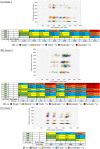Development of multiplex RT-ddPCR assays for detection of SARS-CoV-2 and other common respiratory virus infections
- PMID: 36517993
- PMCID: PMC9835441
- DOI: 10.1111/irv.13084
Development of multiplex RT-ddPCR assays for detection of SARS-CoV-2 and other common respiratory virus infections
Abstract
Background: Measures for mitigation of Coronavirus Disease 2019 (COVID-19) were set to reduce the spread of Severe Acute Respiratory Syndrome Coronavirus 2 (SARS-CoV-2). SARS-CoV-2 and other respiratory viruses share similar transmission routes and some common clinical manifestations. Co-circulation of SARS-CoV-2 and other common respiratory viruses is imminent. Therefore, development of multiplex assays for detecting these respiratory viruses is essential for being prepared for future outbreaks of respiratory viruses.
Methods: A panel of three reverse transcription droplet digital PCR (RT-ddPCR) assays were developed to detect 15 different human respiratory viruses. Evaluations of its performance were demonstrated. A total of 100 local and 98 imported COVID-19 cases in Hong Kong were screened for co-infection with other common respiratory viruses.
Results: All detected viral targets showed distinct signal clusters using the multiplex RT-ddPCR assays. These assays have a broad range of linearity and good intra-/inter-assay reproducibility for each target. The lower limits of quantification for all targets were ≤46 copies per reaction. Six imported cases of COVID-19 were found to be co-infected with other respiratory viruses, whereas no local case of co-infection was observed.
Conclusions: The multiplex RT-ddPCR assays were demonstrated to be useful for screening of respiratory virus co-infections. The strict preventive measures applied in Hong Kong may be effective in limiting the circulation of other human respiratory viruses. The multiplex assays developed in this study can achieve a robust detection method for clinical and research purposes.
Keywords: COVID-19; RT-ddPCR; SARS-CoV-2; co-infection; human respiratory viruses.
© 2022 The Authors. Influenza and Other Respiratory Viruses published by John Wiley & Sons Ltd.
Conflict of interest statement
The authors declare that they have no competing interests.
Figures





References
Publication types
MeSH terms
Grants and funding
LinkOut - more resources
Full Text Sources
Other Literature Sources
Medical
Miscellaneous

